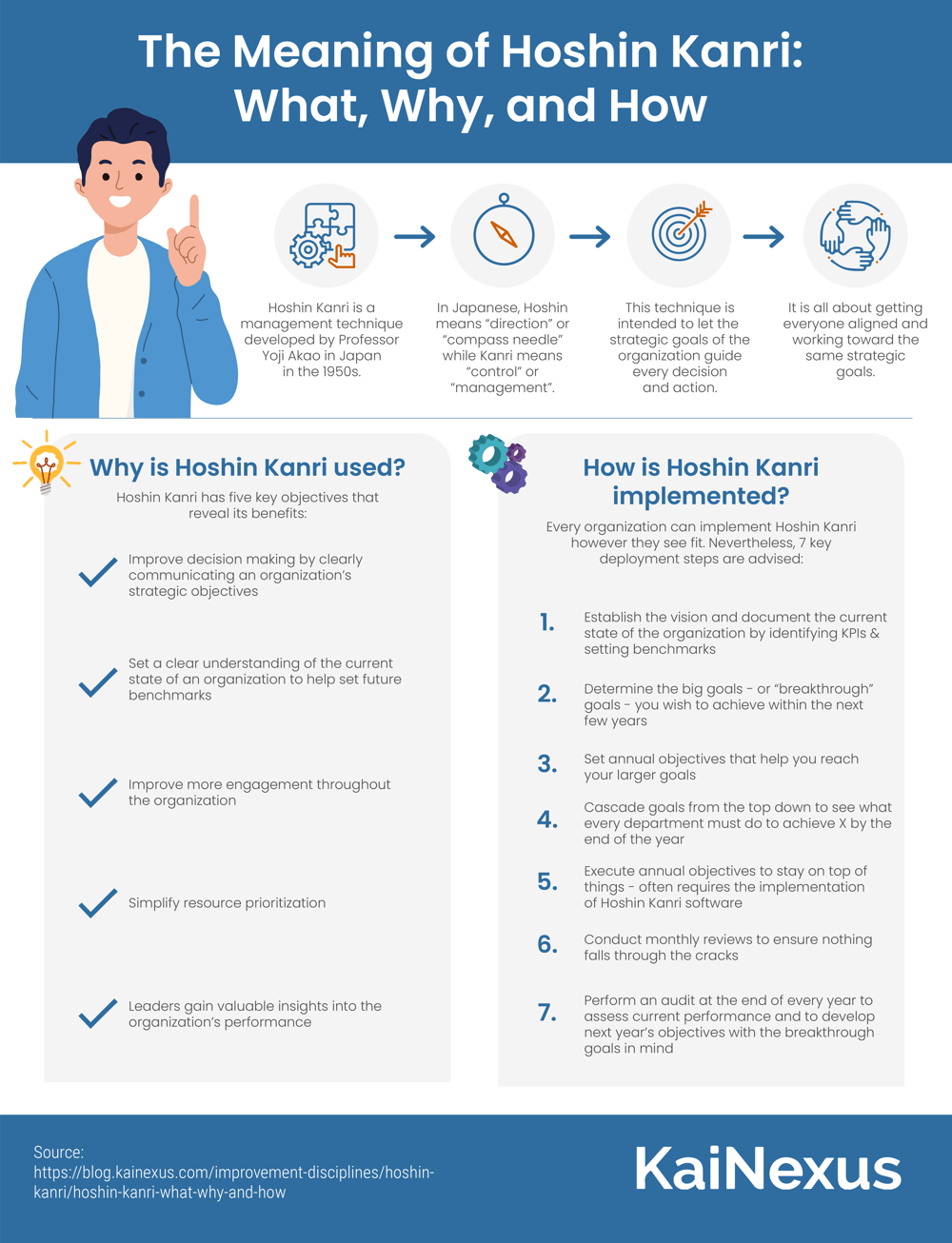 We are fortunate enough to get to spend a lot of time chatting with customers and other organizations that are interested in continuous improvement about how they approach the need for constant positive change.
We are fortunate enough to get to spend a lot of time chatting with customers and other organizations that are interested in continuous improvement about how they approach the need for constant positive change.
Many techniques that are used in the Lean and Six Sigma management approaches come up during these conversations, but one that seems to be less understood than many others is Hoshin Kanri.
This blog unpacks what Hoshin Kanri really is, why it matters for Continuous Improvement and Operational Excellence leaders, and how to put it into action across your organization.
What is Hoshin Kanri?
Hoshin Kanri is a management technique that was first developed by Professor Yoji Akao in Japan in the 1950s. He believed that "Each person is the expert in his or her own job, and Japanese TQC [Total Quality Control] is designed to use the collective thinking power of all employees to make their organization the best in its field."
The Japanese word Hoshin means “direction” or “compass needle.” Kanri means “control” or “management.” This reflects the intention of the technique to let the strategic goals of the organization guide every decision and action. People who use Hoshin Kanri can often refer to “true north.” They work to get everyone aligned and working toward the same strategic goals. In some organizations, Hoshin Kanri is called “policy deployment” or “strategy deployment.”
For leaders responsible for continuous improvement, Hoshin Kanri becomes the connection between vision and execution, strategy and operations, leadership and frontline teams.
Why do organizations rely on Hoshin Kanri?
Here are five principles that reveal why it's so impactful for CI and OpEx leaders:
1. The organization’s strategic objectives are clearly and widely communicated
When Hoshin Kanri is deployed, generally three to five breakthrough objectives are identified and communicated at every layer of the organization. By aligning everyone with the organization's goals, Hoshin Kanri streamlines decision-making processes and resolves disputes more efficiently. This clarity enables employees to focus their efforts on activities that directly contribute to achieving strategic objectives, thereby enhancing productivity and effectiveness.
2. A clear understanding of the current state is established
One might think of Hoshin Kanri as a map of the desired state of the organization. Like any useful map, it is essential to start with, “You are here.” Understanding the current state helps organizations identify strengths and weaknesses, enabling them to develop strategies and action plans that address specific challenges. This proactive approach enhances the organization's ability to adapt to changes in the external environment and maintain competitiveness.
3. Hoshin Kanri results in widespread engagement
Unlike other strategic planning approaches, Hoshin Kanri takes on a life within the entire organization. The goals, objectives, and improvement work of every person, department, and team are aligned with True North. People also feel more invested and engaged when they understand how their work relates to the bigger picture. This increased engagement can lead to higher levels of innovation, collaboration, and overall performance.
4. Hoshin Kanri simplifies resource prioritization
We have yet to find an organization with unlimited resources to devote to improvement work. Without clear strategic direction, there can be valid arguments for all sorts of projects, making it difficult to decide how to invest for the most impact. By prioritizing initiatives that align with strategic objectives, organizations can maximize the return on investment and achieve their goals more efficiently. This focus on resource prioritization enables organizations to make strategic decisions that drive sustainable growth and competitiveness.
5. Leaders gain valuable performance insight
Because key performance indicators are identified and benchmarks established early on, leaders have a rock-solid way to determine if acceptable progress is being made. They can easily identify when momentum stalls and intercede proactively to resolve problems and apply additional resources as needed. This focus on performance insight enhances the organization's ability to adapt to changing market conditions and maintain a competitive edge.
How is Hoshin Kanri deployed?
Of course, each organization is free to implement Hoshin Kanri in a way that works for them, but there are generally seven steps to deployment. They align perfectly with the principles and benefits listed above.
1. Establish the vision and document the current state
The mission, vision, and values of the organization are assessed and, if necessary, adjusted to reflect the desired future state. As we mentioned, the KPIs are identified and benchmarks are completed.
2. Determine the breakthrough goals
Hoshin Kanri is really about achieving big goals that will change the organization for the positive. These “breakthrough” goals may involve new products, new markets, or a new business model. They typically take three to five years to achieve.
3. Set annual objectives
What makes Hoshin Kanri effective is that these long-term, big challenges are broken down into achievable chunks starting at the annual level. If we want to get to X by the end of year three, where will we need to be when year one comes to a close?
4. Cascade goals from the top down
If the company is going to achieve X by the end of the year, what does every department, team, and individual need to accomplish to make that happen?
5. Execute annual objectives
A variety of techniques can be leveraged to ensure that every part of the organization stays on track. Hoshin Kanri software is often deployed to give leaders insight into progress and drive daily activities.
6. Conduct monthly reviews
Hoshin Kanri is not a “set-it-and-forget-it” approach to strategic management. Rather it requires hands-on work at every level. Monthly reviews ensure that nothing falls through the cracks and that the annual results are as expected.
7. Perform annual audits
At the end of 12 months, it is time for a thorough assessment of the new current state and development of the next year’s objectives. If progress toward the breakthrough objectives isn’t sufficient, those objectives are reassessed, and remedial actions are taken.
Although the name may be a little intimidating. Hoshin Kanri isn’t a complex concept. It is, however, brilliant in its focus on long-term objectives that may otherwise get lost in the day-to-day effort to keep processes operational. The approach reminds everyone of the larger picture and gives each person a concrete way to contribute to organizational transformation.

![[Watch Now] Cascading Strategy Through Hoshin Kanri](https://no-cache.hubspot.com/cta/default/326641/dd5ad176-fb74-4e1e-bf28-ff4d966d1701.png)



Add a Comment